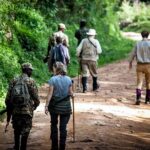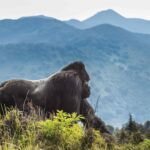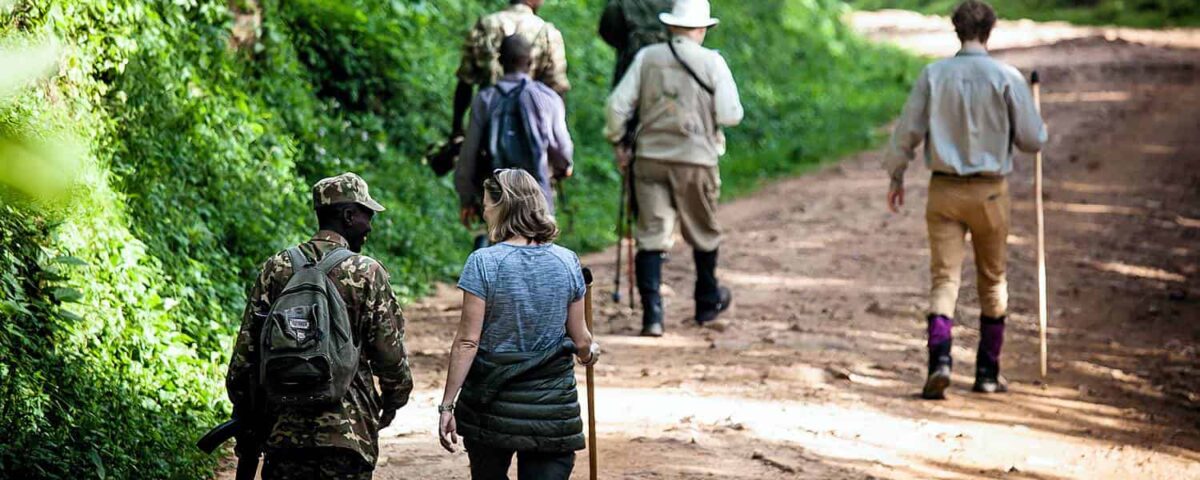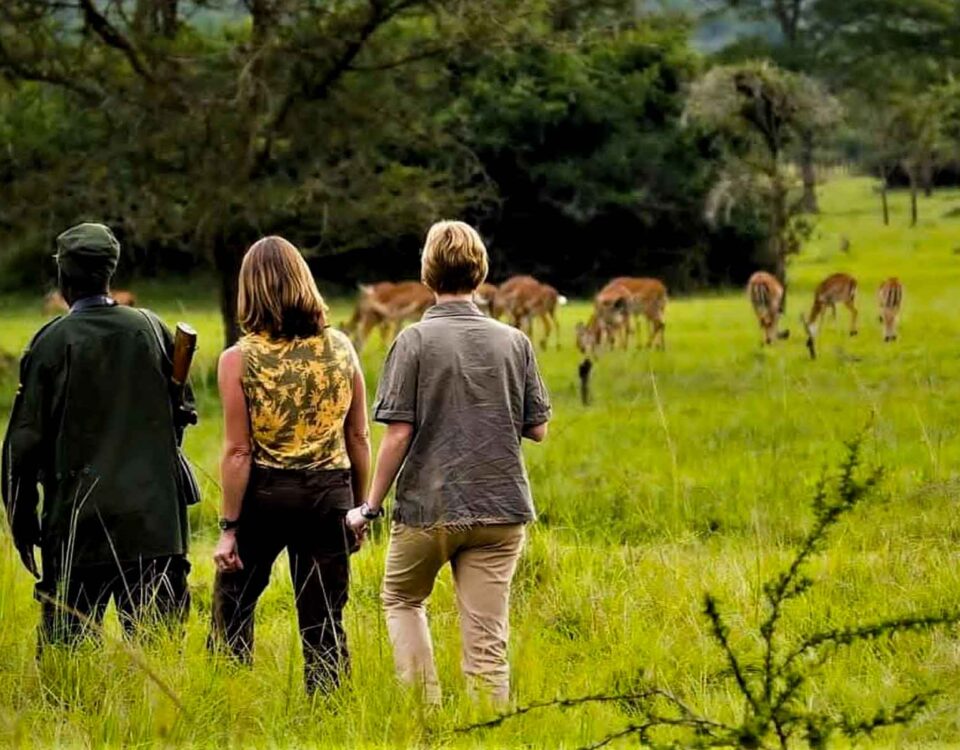
How do I book a walking safari in Uganda?
August 9, 2025
How Much Does a Gorilla Trekking Safari in Uganda Cost?
August 10, 2025How Much Does a Walking Safari in Uganda Cost?
If you are an adventurous traveler looking for a truly immersive African experience, you might be asking yourself, “How much does a walking safari in Uganda cost?” Walking safaris in Uganda offer an up-close and personal encounter with the untamed beauty of the Pearl of Africa. Unlike traditional game drives where you view wildlife from the safety of a vehicle, a walking safari allows you to experience nature at ground level—smelling the fresh wilderness air, hearing the rustle of leaves, and following the tracks of animals under the guidance of an expert ranger. This slow-paced exploration opens opportunities to spot smaller creatures, diverse bird species, and even the larger game like elephants, giraffes, and buffalo in their natural habitat.
Uganda, famous for Gorilla Trekking in Bwindi Impenetrable National Park and Chimpanzee Tracking in Kibale Forest, is also a top destination for unique walking safaris in places like Murchison Falls National Park, Lake Mburo National Park, and Kidepo Valley National Park. While Kenya Safaris and Tanzania Safaris are celebrated for their vast savannahs and wildebeest migrations, Uganda offers a more intimate and less crowded wildlife safari experience. For travelers looking to combine multiple adventures, it’s even possible to pair a Uganda walking safari with Rwanda safari tours or extend into East Africa’s top attractions.
The cost of a walking safari in Uganda varies depending on the location, the length of the walk, and whether it is part of a longer Uganda safari itinerary that may also include Gorilla Trekking or Chimpanzee Tracking. Murchison Falls Tours, one of the most trusted local operators, can help you arrange both private and group walking safaris through the Uganda Wildlife Authority (UWA) or directly through your lodge.
Cost of a Walking Safari in Uganda
When considering how much does a walking safari in Uganda cost, it’s important to know that prices differ depending on the park and operator. Generally, a guided walking safari in Uganda’s national parks costs between USD 30 and USD 50 per person for a short nature walk, while extended walking safaris lasting several hours can range from USD 50 to USD 100 per person. These rates are set by the Uganda Wildlife Authority and sometimes adjusted by private lodges that offer exclusive guided walks.
For example, a short morning nature walk in Lake Mburo National Park may cost around USD 30, while a more specialized experience, such as a Rhino Tracking walk at Ziwa Rhino Sanctuary, costs approximately USD 50 per person. If your walking safari is part of a larger Uganda safari package that also includes game drives, boat cruises, and cultural tours, the per-activity cost may be lower as it’s bundled with other experiences.
Travelers planning to combine a walking safari in Uganda with Gorilla Trekking should note that gorilla permits currently cost USD 800 per person in Uganda (effective July 2024), while Rwanda safari gorilla permits are USD 1,500. Chimpanzee Tracking permits in Uganda range from USD 250 in Kibale Forest to about USD 100 in other reserves like Kyambura Gorge. All permits can be booked through Uganda Wildlife Authority, Rwanda Development Board (for Rwanda safaris), or licensed operators such as Murchison Falls Tours.
Gorilla & Chimpanzee Permits – Prices, Booking, and Age Limits
A major reason travelers choose Uganda for safaris is to combine walking safaris with Gorilla Trekking and Chimpanzee Tracking. When answering how much does a walking safari in Uganda cost, it’s worth including permit fees for these primate encounters, as they are often part of a full itinerary.
- Gorilla Trekking Permits (Uganda): USD 800 per person (from July 2024)
- Gorilla Trekking Permits (Rwanda): USD 1,500 per person
- Chimpanzee Tracking Permits (Kibale Forest, Uganda): USD 250 per person
- Chimpanzee Tracking Permits (Kyambura Gorge or Kalinzu, Uganda): USD 100 per person
The age limit for Gorilla Trekking and Chimpanzee Tracking in both Uganda and Rwanda is 15 years old. This is strictly enforced for safety and conservation reasons.
Booking Permits: It’s highly recommended to secure your gorilla or chimpanzee permit at least 3–6 months in advance, especially during the high season (June–September and December–February). You can obtain permits through Uganda Wildlife Authority’s official channels, the Rwanda Development Board, or a licensed tour operator like Murchison Falls Tours who can handle all arrangements as part of your Uganda safari package.
Best Time to Do Gorilla & Chimpanzee Trekking with a Walking Safari
When considering how much does a walking safari in Uganda cost, you should also think about the timing of your trip. The best months for walking safaris, Gorilla Trekking, and Chimpanzee Tracking are during the dry seasons:
- June to September
- December to February
During these months, the trails are less slippery, visibility is better, and wildlife is more concentrated around water sources, making sightings easier. However, walking safaris can still be done in the wet seasons (March–May, October–November) for those who prefer fewer tourists and lush green scenery—though you’ll need good rain gear.
Many travelers choose to combine a walking safari in Uganda with Gorilla Trekking during the same trip. This allows you to enjoy both the close-up intimacy of exploring on foot and the awe-inspiring encounter with endangered mountain gorillas. Adding Kenya Safaris or Tanzania Safaris after your Uganda trip is also a great way to experience the wildebeest migration or Serengeti big cat action.
What to Pack for a Gorilla, Chimpanzee, and Walking Safari in Uganda
A well-prepared packing list can make a huge difference in your walking safari experience. If you’re asking how much does a walking safari in Uganda cost, remember to budget for quality gear as well.
Clothing & Footwear
- Lightweight, breathable clothes in neutral colors (avoid white, bright colors, or camouflage)
- Sturdy hiking boots for Gorilla Trekking, Chimpanzee Tracking, and walking safaris
- Waterproof jacket and poncho for sudden rain showers
- Long-sleeved shirts and trousers for protection against insects and plants
Accessories & Essentials
- Daypack for carrying water, snacks, and a camera
- Wide-brim hat, sunglasses, and sunscreen
- Binoculars for birdwatching and spotting wildlife
- Garden gloves for Gorilla Trekking to grip vegetation
Health & Safety
- Insect repellent with DEET
- Personal medication and a small first aid kit
- Refillable water bottle
Packing appropriately ensures comfort, safety, and better enjoyment of your walking safari and primate tracking experience.
Cultural Experiences to Combine with a Walking Safari in Uganda
While exploring how much does a walking safari in Uganda cost, don’t forget to consider the cultural add-ons that make the journey even richer. Uganda’s diverse ethnic communities offer immersive experiences you can enjoy alongside wildlife activities.
- Batwa Cultural Experience: In Bwindi and Mgahinga, the Batwa people—original forest dwellers—share their traditional hunting techniques, music, and dances.
- Karamojong Village Visit: Near Kidepo Valley National Park, meet Uganda’s cattle-herding nomads and learn about their warrior traditions.
- Buganda Kingdom Heritage Tour: Around Kampala, explore royal tombs, palaces, and traditional crafts.
These cultural activities can easily be included in an itinerary that pairs a walking safari with Gorilla Trekking, Chimpanzee Tracking, or even cross-border Kenya Safaris and Rwanda Safaris for a fuller East African experience.
Combining Uganda Walking Safaris with Gorilla Trekking
For many travelers asking how much does a walking safari in Uganda cost, the real goal is to make the most of their trip by combining different experiences. A typical itinerary could start with a walking safari in Murchison Falls National Park—exploring the savannah on foot—then continue to Kibale Forest for Chimpanzee Tracking, and finally head to Bwindi Impenetrable National Park for Gorilla Trekking.
Such a combination not only offers diverse wildlife sightings but also gives you the chance to explore Uganda’s varied landscapes, from open grasslands to tropical rainforests. If time allows, you could extend your trip into Rwanda for Volcanoes National Park or fly to Kenya and Tanzania for iconic savannah safaris.


